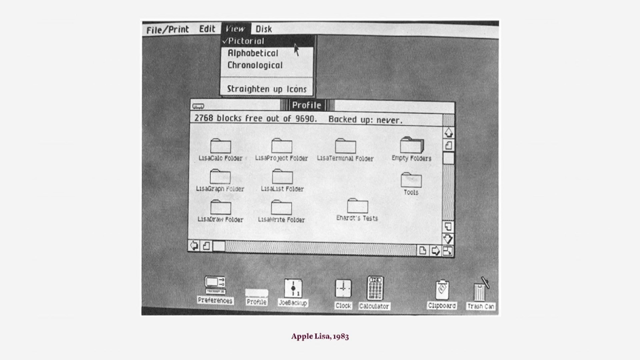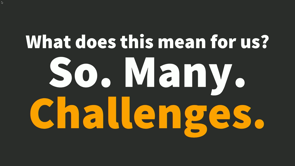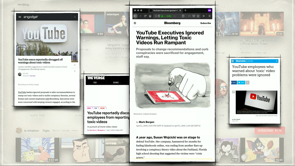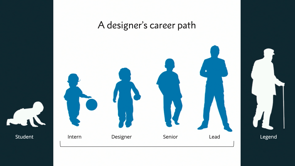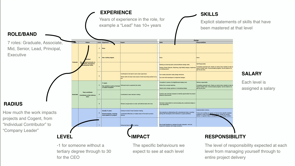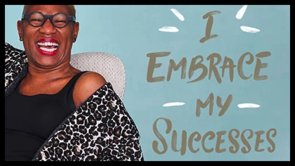How to be a Design Leader and Keep Designing

(upbeat music) - So, I work at Canva, and Canva is an online publishing platform, and our catchphrase is that anyone can design anything and publish it anywhere.
So, that's my spiel, this is what Canva looks like on the homepage, now a beautiful homepage, and our new editor as well is brilliant, so people can easily create any sort of documents they want by dragging and dropping elements, and it's really easy for people who like to use it. But (coughing) I wanted to talk today about (mumbles) how to be a design leader and keep designing. So, this is (laughing) the team at the moment at Canva, this is in January, we had a big get together. And we're growing, as mentioned before.
So, we've been doubling our headcount every year, pretty much, it's only just a quarter of the way through 2019 and we're already on our way to doubling again for the year.
But the average tenure at Canva is quite short, so most people are new, most people are newbies.
I'm going to stand still.
I'm actually one of those speakers that likes to walk around, so this is going to be tough for me. But what about the product design team? So, this is what the product design team looked like when I came on board about six months ago.
And, it's a really really tight team.
They'd already achieved quite a lot of success as just a product, but also as a business with this tight unit. And some of you might recognise Cameron Adams. So, Cam was also founder of Canva, one of three. And so, to have the founder also building this design team internally was quite daunting for me.
He'd created a really unique design culture at Canva, as you can probably expect.
Those that have actually met Cam and worked with him, he has very specific ideas about what design is and what it isn't, and it was my, I guess, honour, if you like, to take that and basically scale it.
The problem that we first had though was that Canva was growing as I mentioned, like doubling every year, and most of that was with engineers.
So that's the engineers coming.
So, the first thing I looked at was what are the other ratios out there of engineers to designers? This is just a smattering of data.
It's really hard to get this stuff, it's often through just pinging emails, trying to get medium blogs and we kind of saw that there was some big variances.
It looked like one to eight was pretty good, and you can see some really big changes there at IBM, and obviously into (mumbles) we'd expect pretty low.
Last year, we were sitting about one designer to 18 engineers, which is a real battle.
And this year, already we've got it down to one to 10, and we're thinking about where we want to go next. And I think that this raw number is interesting, but it's not really how I want to measure the growth of my team, so I've been thinking a little bit more about that. As I mentioned, our headcount will be doubling every year, this is our new building which we moved into last week. So, yes.
There's a lot to do.
And I was pretty daunted by this whole thing. And it also meant that I had to think about, like I really like opening, like working with Sketch and opening Figma and doing some designs, and really being a part of that, but it felt like this role, I wasn't really going to help much if I was doing that. So, I needed to design what the company and the team needed from this team.
I obviously read all the books, and these are two amazing books, Julie's new one is really great and just came out recently. But, what I wanted to sort of think about is that my team isn't really a playbook.
There's lots of really great techniques and thoughts in these books, but I didn't sort of just want to come in and just apply them like a playbook, and just sort of, you know, go through the motions.
So, the way I decided to think about it was that my design team is actually a product.
And, I am the product designer (laughing).
So, this is a big moment for realisation for me, where I realise that actually I'm still a designer, I'm just designing my team.
And it's not like designing a landing page, or something like that, I'm actually designing very much a living, breathing product that's got, you know, metrics and, you know, a lot of the things you'd expect to have from a product. So, then I thought to myself, what are the characteristics of the best products, if I think about that design team as a product, I've ever used? I'm going to go through four, and I'm also going to have these are the problems or these are the things I've liked, and this is kind of what I realised I need to do, and I'm going to match them up as I go.
So, first one, most product design teams I've ever worked with, no-one really talked much crap.
So the first thing that we did was, well, I didn't actually have to do much here anyway, coming in a lot of these words weren't being used at all. It's one of the first things I noticed actually when I came into Canva was that there was a real lack of buzzword usage and a lot of just people getting on and getting things done.
We did have the usual design process diagrams that we tried to wrangle and tried to put together, and of course there's all of these double diamonds that you could sort of reference, but I sort of, we decided as a team that we wanted to put that in the bin, and think about what the jobs were of a designer at Canva. So, there's really three things.
One is to show the future.
So, it's really important for us as we're moving so quickly that we're able to really articulate what's happening in three months and one year.
Second, is building and launching it.
We're still very much feeling like a start-up even though we are getting larger, and so the shipping culture is quite strong. You can't really survive as the designer at Canva if you aren't shipping features, and shipping awesome ones.
So, you need to keep that in mind.
But also, experimenting.
So, every product designer at Canva is expected to also be running experiments, living in the data, or at least getting a lot of help to do it. These are the three jobs that we have.
We didn't want to look at, these are the things that the team needed, if you like, to actually be doing a great job.
So, that was the first one.
Sorry, I'll just get some water.
The second, as I said, everyone was awesome in their role.
So, hiring for fit.
So, I'm going to talk a little bit about hiring because I've been doing it a lot lately.
So, again, the design team is a product, I am the product designer.
So, essentially, I wanted to sort of get the team to sort of fit what the company needed.
And, as I mentioned before, they were quite close knit, still are, and needed to scale without diluting that culture. I didn't want to make the team into my image, white male, and I didn't want to hire necessarily a whole bunch of UX designers, UI designers, information architects, researchers or necessarily do a sort of check box, if you like, of all the skills I needed to fit that.
I've seen that approach and I think it's something I maybe will experiment with later, but I was sort of interested in trying to find a new sort of way to hire.
So, our existing hiring process, I'll just quickly go through it, was okay, we did a lot of (mumbles) pooling, so we looked a lot at locations and channels, we did a portfolio review which was done by the recruiter, we did a challenge which was sent by the recruiter, it was a basically a Canva t-shirt challenge, so a flow in Canva to create a t-shirt, and there was an eight hour expectation of effort. A Canva designer would only then review the challenge, in isolation but also with a design lead, and then there was some final top grading interviews, career chronology, that sort of thing, with a designer, a design lead and a product manager. And then we'd give an offer.
We had some feedback though.
So, most of the respondents we talked to spent over 10 hours completing the challenge.
And, over a quarter last year, an average quarter that I could get from the data, we would send out about 13 challenges, and only seven would come back, and we would result in one hire.
So, if you're considering all of these engineers coming in, this is clearly not going to cut it and we need to change what we're doing.
We had some interesting feedback as well which I had thought a lot about as well, so, the first one was around actually, you know, getting candidates to do a challenge that's actually related to the product that they're being hired in for.
And, I guess the feeling that this is actually not very ethical at all.
We weren't paying candidates, I know this is also another technique that some do, and I guess we had this feeling that it's our product, we want somebody to come in that would really fit it and understand it, it wasn't done in a way to like, get personal IP or anything like that, but it was certainly perceived by some to be that.
And, the interview process was really long as well. So, we did a few things differently.
First of all, the pooling.
So, I really wanted to get a more diverse set of candidates in there, and the only way I really figured we could do that was by going a little wider at the top of the funnel on the pooling.
So, we looked at a lot more different channels for more diverse candidates.
The portfolio review, so, the recruiter would screen and then actually I would sit down with the product designer and actually do a face to face interview.
The challenge itself we changed, so, I would actually brief in the challenge to the candidate, the take-home challenge was a non-Canva challenge, so it was sort of a made up challenge, that only had four hours expectation.
It was still take-home, we had a lot of pressure to do an in-house challenge, but it was a bit hard for us as we were hiring from overseas as well.
So, we didn't want to disadvantage candidates if they were on video or Sydney based.
We also reviewed the challenge together, nothing much changing there, and the only change to the final review was that I actually tried to, in most cases, I would get the group product manager, so the more senior product manager that was probably going to be working with this candidate if they were hired, to be part of that final top grading.
And we almost turned it into a bit more of a natural conversation that you would have between a product manager and a designer, and the offer.
Result! So, in the last four months, we actually hired seven people, Four women, and three men, which has actually been probably the kind of biggest, I would say the biggest success so far in our team to date, I guess within the last six months, because we've sent 16, we've had 16 returned, and we've increased the diversity of our team, which is awesome.
The third one is, in most awesome product teams I've been in I've learnt so much and, I wanted to get the feeling of learning on the job within our team.
So, again, I am the product designer of the product design team. There's lots of learning frameworks and everything out there, I'm sure everyone's seen, there's lots of thoughts about how you could be a designer and grow, how you could be an individual contributor and grow, or do I go down a managerial track? And there's a lot of that in the design effort Design Org book, which I highly recommend reading.
But, I again wanted to sort of challenge it a little bit, and it's sort of early days on this but I'm thinking about this dichotomy if you like, of a craftsperson and a manager.
I've just got to clear my voice, I'm sorry.
(coughing) So, I've been faced with this conundrum personally like a lot of times, and we have a lot of people in the team that are really heavy, intuitive craftsmen, they will come up with a prototype for a new feature in our app passionately, like how are we going to get video editing into our app, and they'll do it and turn around prototypes in a couple of days, and then they get that out to testing, and then talk to engineers, and get that going, and I didn't want that person to feel like they couldn't do that anymore if that was the thing that they loved to do.
But, also, we're growing as a team, and it's not really possible for me to have, so, we have 25 product designers in our team, and it's not possible for me to have 25 one-on-ones, without going crazy.
So, I kind of wanted to challenge this a little bit, and was thinking about different career paths instead. So, one of the career paths that someone can have is a very linear career path.
So I'm a graduate, at a consulting firm, I need to create a set amount of skills and achievements to get to y because I want to get to z and z could be to be Director of design at a consultant company. And I spend a lot of my time maybe thinking, five years ahead, that's exactly where I want to go, like in this kind of straight line.
Whereas the other career path that I felt like we could start to support at Canva is potentially one that's around more emergent.
So, that would be, I'm starting at x, I've got a couple of ideas for y, what they could be, but I'm going to just take the right one at the right time, when it comes to me, when there's an actual opportunity to do it. So, people who have heard me speak before know I am a big believer in actually growing with the opportunity, because it's more realistic, than sort of having lofty career goals, and sort of doing them in your own time and kind of failing at both. So, spending time then thinking about what are my options here potentially for my next role? I'm not sure exactly what it would be, but if the right opportunity presents itself then I can go for it more confidently.
And, again, when you get to the next level, in the z sort of area, you kind of end up still growing in certain ways, and still feeling like you're progressing, but not actually having to have that, you know, necessarily that linear career path, if you don't want it.
Some of the, sometimes the worst thing that can happen for designers in your team, if you do create these linear career paths, is that they actually achieve them.
And they miss a lot of opportunities to get to all those other z parts that are there.
That's something that I've certainly found managing designers in the past.
So, how can I do that? So, in trying to figure out different ways to do this, this is my latest thinking, it's that we have some pillars that I work on in my one-on-ones with my team members.
Number one, so they're at the bottom here, focus on your craft.
So, this is still, even as a manager, you have to still think about the craft that you have.
And that could be, you know, just crafting really great communications, or being very good at being proactive in white-boarding and moving things along, moving things along is probably a big part of your craft if you're a manager.
The second is communication times ten.
So, that basically means, you know, this is a part of being a great designer, is that if you can actually communicate 10 times better than everyone else. That should be a goal that I always talk about with some of my team members.
Showing the future, as I mentioned before, I think especially for Canva, we have this sort-of huge opportunity in front of us, and we need to be able to get everyone excited, and articulate it.
And then also, mentoring and coaching.
So, I look through these four whenever I'm talking to my team members one-on-one.
Cool.
So, we plan around seasons at Canva, which is quarters, and every season there's really two types of planning that we do.
So, focusing on your craft is a goal that I ask my team members to set within their groups.
So that's within their cross-functional group, squad or whatever you call it.
I actually don't have too much to do with that, I just want to make that sort of happen, if there's little things I can do get there I'm aware of it, but it's not something that I'm really focusing on. Whereas the other three, communication, strategy or showing the future, mentoring and coaching, or leadership if you want to call it that, I work with my mentees and find a tangible goal that isn't homework.
So there's actually an opportunity and you're going to hit that within your group, and only one of those, so just picking one. So, it's usually, so, over a year, hopefully you've had chance to do that sort of four times, and you can sort of try to get that emergent career path. Okay.
And, the last one, I thought through solutions really well when I was in a product design team that I loved.
I kind of had a lot of moments where I went deep on things. I had a lot of moments where I had deep work. Coming into the design team, obviously you do your sort of listening tour where you go and talk to everybody and you sort of ask, "Hey, how's it going? What's the biggest problem you've got at the moment around your work?" It was really around, you know, people things, like I don't like the person I'm working with, or I don't like the leadership, it wasn't anything like that.
It was often I just don't have time to do deep work. I feel like I've never seen it so bad before, in a company where I'd worked in or a product team where designers were being sort of, content switching like crazy, and I think a lot of that was just due to the growth of the team.
So, I thought a lot about deep work, and I tried to take some concepts, so there's a really amazing book called Deep Work out there, and I tried to take some concepts of that and tried to make them a bit more tangible.
So, as I mentioned before we had a 1:18 problem. So, one designer, sorry for any engineers out there, I've called you geeks, but maybe a bearded product manager up there, some cowboy in a sales team asking you to put a deck together, you know, all of these sorts of things were coming at our product designers.
So, we created a mandatory within the team. We got 3 by 3.
Every week, we have to create 3 hours of non-interrupted time, three times a week.
And the non-interrupted time is really critical. I didn't say 3 hours a day, or I didn't say block of the first half of your day, or anything like that.
It was more like let's try and find three consecutive hours, because after three consecutive hours you tend to have gone deep enough on a problem that you've pushed it forward. Pushing things forward and getting progress on it, real progress is meaningful.
So, to do that, I kind of put together a few different ways to think about our cadence within the team.
So, we still need to have our meetings and we still need to keep up to date.
I'll go through this quickly because I'm running a bit short on time.
The first one is to stay in the loop.
We have a weekly meeting on Mondays, and basically everyone just brings their Macbook, turns it around, and just says "I'm working on this", and everyone looks and goes, "Okay, cool I've got that" and then you talk about it quickly.
There's no note-taking or I'm doing this today, last week I did, this week I did, none of that, just basically let's just show and keep it going. Finding time for deep work, I'll go, I'll talk about that in a second, sorry, these are a bit out of order.
The third was share and learn, so the first Thursday of the month we have a design salon, where we have one of our team members presenting some inspirational, useful case study, anything that would be beneficial to the whole group. Last week we had a really big Q&A on Figma, and did basically a retro on Figma.
And also, get feedback.
So, every week, except for one week a month, we do a design critique where we have three people presenting for 15 minutes over 45 minutes. Usually, actually it always goes long, that usually goes for an hour and a half to give that constructive feedback. So, these are the non-negotiables that we need. We also have our team outing once a month to unwind and catch up.
This is one of those ones that's really easy to sort of kick down the road, "Ah, we'll do it next month, we'll do it next month", kick it down the road, but I actually take this meeting the most seriously in terms of planning in my group and trying to find meaningful outings like going to see an interesting movie together, talking about it afterwards, getting a cocktail, that sort of thing.
But the one thing that I think that I hadn't done before that I feel has had a really interesting impact is the idea of a design sanctuary.
So, for three hours on a Tuesday, we book, we're lucky enough to have a room now for the designers, the design studio room, before that we just booked a larger meeting room, and I kind of tried to guard it with my life from no-one else booking it.
And it's basically just get away from your groups, get away from that hoard of engineers and product managers trying to grab all your time and just get into the sanctuary.
And so everyone just comes in, I take an order of bubble tea before we come in to encourage everyone to come in, and we just sit around and just work together as a team. Sometimes there's some spur of the moment discussions happen, one proud moment I would say was when we actually solved a pricing page problem that had like three or four different groups trying to solve the same thing at the same time, and it just kind of happened naturally on a white board, wasn't planned.
And it's actually become, something I've not done before in the team, having this kind of sanctuary, but it was something I felt I needed to do to improve my product, which is my design team.
(mumbles) So, in some ways, the title of my slide, my talk, was not quite accurate.
It did sort of evolve as I wrote it.
Basically, the team is an awesome product.
And you as a leader are actually the product designer, you're designing it every day.
And that's my talk, thank you.
(clapping) (upbeat music)







